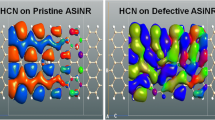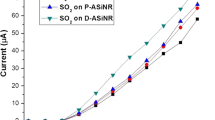Abstract
Using density functional theory (DFT) and non-equilibrium Green’s function (NEGF) formalism, the electronic and transport properties of ammonia (NH3) molecule adsorbed on armchair silicene nanoribbons (ASiNRs) are calculated. Different variants of ASiNR have been considered viz. pristine, defective, Al-doped, and P-doped. It has been observed that though the pristine ASiNR is not much sensitive to this gas molecule, but its sensitivity can be drastically enhanced by introducing defects and dopants. NH3 gas molecule exhibits stronger adsorption on ASiNRs with addition of defect and dopants. The findings are suggestive of defective and Al-doped ASiNRs being more suitable as sensors for NH3 owing to the strong adsorption and large charge transfer of the gas molecule with these ASiNR variants whereas NH3 exhibits physisorption on pristine and P-doped ASiNRs possessing minimal adsorption energy and charge transfer as well. Defective ASiNRs are found to exhibit the strongest adsorption of all resulting in higher current as well. The study indicates that modified ASiNRs are potential candidates for nanoelectronic NH3 gas sensors.





Similar content being viewed by others
References
Aghaei SM, Calizo I (2015) Band gap tuning of armchair silicene nanoribbons using periodic hexagonal holes. J Appl Phys 118:104304
Takeda K, Shirashi K (1994) Theoretical possibility of stage corrugation in Si and Ge analogs of graphite. Phys Rev B 50:14916
Cahangirov S, Topsakal M, Akturk E, Sahin H, Ciraci S (2009) Two- and one-dimensional honeycomb structures of silicon and germanium. Phys Rev Lett 102:236804
Feng B, Ding Z, Meng S, Yao Y, He X, Cheng P, Chen L, Wu K (2012) Evidence of silicene in honeycomb structures of silicon on Ag(111). Nano Lett 12:3507–3511
Vogt P, De Padova DP, Quaresima C, Avila J, Frantzeskakis E, Asensio MC, Resta A, Ealet B, Lay GL (2012) Silicene: compelling experimental evidence for graphene like two-dimensional silicon. Phys Rev Lett 108:155501
Osborn TH, Farajian AA, Pupysheva OV, Aga RS, Voon LC (2011) Ab initio simulations of silicene hydrogenation. Chem Phys Lett 511(1):101–105
Spencer MJS Morishita T (2016) Silicene, Springer Series in Materials Science Volume 235. Switzerland
Voon LC (2016) Physical properties of silicene, In: Spencer MJS, Morishita T (eds.), Silicene, Springer Series in Materials Science 235, Switzerland pp 3–34
Peplow M (2015) Silicene makes its transistor debut. Nature 518(7537):17–18
Zha D, Chen C, Wu J (2015) Electronic transport through a silicene-based zigzag and armchair junction. Solid State Commun 219:21–24
Nakano H, Ohashi M (2016) Soft chemical synthesis of functionalized silicene, In: Spencer MJS, Morishita T (eds.), Silicene, Springer Series in Materials Science 235, Switzerland pp 85–106
Spencer MJS, Morishita T (2016) Theoretical studies of functionalised silicene, In: Spencer MJS, Morishita T (eds.), Silicene, Springer Series in Materials Science 235, Switzerland pp 107–128
Houssa M, van den Broek B, Scalise E, Pourtois G, Afanasev VV, Stesmans A (2013) An electric field tunable energy band gap at silicene/(0001) ZnS interfaces. Phys Chem Chem Phys 15:3702–3705
Drummond ND, Zólyomi V, Fal’ko VI (2012) Electrically tunable band gap in silicene. Phys Rev B Condens Matter 85:075423
Kaloni TP, Schreckenbach G, Freund MS (2014) Large enhancement and tunable band gap in silicene by small organic molecule adsorption. J Phys Chem C 118:23361–23367
Denis PA (2015) Stacked functionalized silicene: a powerful system to adjust the electronic structure of silicene. Phys Chem Chem Phys 17:5393–5402
Kaloni TP, Singh N, Schwingenschlögl U (2014) Prediction of a quantum anomalous hall state in co-decorated silicene. Phys Rev B Condens Matter 89:035409
Prasongkit J, Amorim RG, Chakraborty S, Ahuja R, Scheicher RH, Amornkitbamrung V (2015) Highly sensitive and selective gas detection based on silicene. J Phys Chem C 119:16934–16940
Feng J-W, Liu Y-J, Wang H-X, Zhao J-X, Cai Q-H, Wang X-Z (2014) Gas adsorption on silicene: a theoretical study. Comput Mater Sci 87:218–226
Iordanidou K, Houssa M, Broek BVD, Pourtois G, Afanasev VV, Stesmans A (2016) Impact of point defects on the electronic and transport properties of silicene nanoribbons. J Phys Condens Matter 28(3):035302
Du Y, Xu X (2016) Adsorption of molecules on silicene. In: Spencer MJS, Morishita T (eds.), Silicene, Springer Series in Materials Science 235, Switzerland pp 215–242
Lin X, Ni J (2012) Much stronger binding of metal adatoms to silicene than to graphene: a first-principles study. Phys Rev B 86:075440
Noor-A-Alam M, Kim HJ, Shin YH (2015) Hydrogen and fluorine co-decorated silicene: a first principles study of piezoelectric properties. J Appl Phys 117:224304
Gao N, Zheng WT, Jiang Q (2012) Density functional theory calculations for two-dimensional silicene with halogen functionalization. Phys Chem Chem Phys 14(1):257–261
Sahin H, Peeters FM (2013) Adsorption of alkali, alkaline-earth, and 3d transition metal atoms on silicene. Phys Rev B 87:085423
Friedlein R, Fleurence A, Sadowski JT (2013) Tuning of silicene-substrate interactions with potassium adsorption. Appl Phys Lett 102:221603
Tritsaris GA, Kaxiras E, Meng S, Wang E (2013) Adsorption and diffusion of lithium on layered silicon for li-ion storage. Nano Lett 13(5):2258–2263
Wang J, Li J, Li S-S, Liu Y (2013) Hydrogen storage by metalized silicene and silicane. J Appl Phys 114:124309
Li C, Yang S, Li S-S, Xia J-B, Li J (2013) Au-decorated silicene: design of a high-activity catalyst toward CO oxidation. J Phys Chem C 117:483–488
Sivek J, Sahin H, Partoens B, Peeters FM (2013) Adsorption and absorption of boron, nitrogen, aluminium, and phosphorus on silicene: stability and electronic and phonon properties. Phys Rev B 87:085444
Ni Z, Zhong H, Jiang X, Quhe R, Luo G, Wang Y, Ye M, Yang J, Shi J, Lu J (2014) Tunable band gap and doping type in silicene by surface adsorption: towards tunneling transistors. Nano 6:7609–7618
Huang B, Xiang HJ, Wei SH (2013) Chemical functionalization of silicene: spontaneous structural transition and exotic electronic properties. Phys Rev Lett 111(14):145502
Osborn TH, Farajian AA (2014) Silicene nanoribbons as carbon monoxide nanosensors with molecular resolution. Nano Res 7:945
Singh S, Sarkar AD, Singh B, Kaur I (2017) Electronic and transport behavior of doped armchair silicene nanoribbons exhibiting negative differential resistance and its FET performance. RSC Adv 7:12783
Kara A, Enriquez H, Seitsonen AP, Voon LC, Vizzini S, Aufray B, Oughaddou H (2012) A review on silicene-new candidate for electronics. Sci Rep 67:1–18
Hu W, Wu X, Li Z, Yang J (2013) Helium separation via porous silicene based ultimate membrane. Nano 5(19):9062–9066
Hu W, Wu X, Li Z, Yang J (2013) Porous silicene as a hydrogen purification membrane. Phys Chem Chem Phys 15:5753–5757
Brandbyge M, Mozos J-L, Ordejón P, Taylor J, Stokbro K (2002) Density-functional method for nonequilibrium electron transport. Phys Rev B 65:165401
Taylor J, Guo H, Wang J (2001) Ab initio modeling of quantum transport properties of molecular electronic devices. Phys Rev B 63:245407
QuantumWise. Copenhagen, Denmark: Atomistix Toolkit version 2015.0. Available from: http://www.quantumwise.com
Perdew JP, Zunger A (1981) Self-interaction corrections to density functional theory approximations for many electron systems. Phys Rev B 23:5048–5079
Srivastava P, Jaiswal NK, Tripathi GK (2014) Chlorine sensing properties of zigzag boron nitride nanoribbons. Solid State Commun 185:41–46
Yamacli S (2014) Comparison of the electronic transport properties of metallic graphene and silicene nanoribbons. J Nanopart Res 16:2576
Zhang Y-H, Chen Y-B, Zhou K-G, Liu C-H, Zeng J, Zhang H-L, Peng Y (2009) Improving gas sensing properties of graphene by introducing dopants and defects: a first-principles study. Nanotechnology 20:185504
Srivastava P, Jaiswal NK, Sharma V (2014) First-principles investigation of armchair boron nitride nanoribbons for sensing PH3 gas molecules. Superlattice Microst 73:350–358
Chowdhury R, Scarpa F, Adhikari S (2012) Molecular-scale bio-sensing using armchair graphene. J Appl Phys 112:014905
Abadir GB, Walus K, Pulfrey DL (2009) Basis set choice for DFT/NEGF simulations of carbon nanotubes. J Comp Electron 8:1–9
Ding Y, Nia J (2009) Electronic structures of silicon nanoribbons. Appl Phys Lett 95:083115
Wella SA, Syaputra M, Wungu TDK, Suprijadi (2016) The study of electronic structure and properties of silicene for gas sensor application. AIP Conf Proc 1719:030039
Dávila ME, Marele A, De Padova P, Montero I, Hennies F, Pietzsch A, Shariati MN, Gómez-Rodríguez JM, Lay GL (2012) Comparative structural and electronic studies of hydrogen interaction with isolated versus ordered silicon nanoribbons grown on Ag(110). Nanotechnology 23:385703
Jamal GR, Chowdhury MM, Rahman F, Rahman MA, Shabnaz S, Habiba U (2015) Simulation of graphene nanoribbon based gas sensor. Journal of Nanoscience and Nanoengineering 1(2):66–73
Aghaei SM, Monshi MM, Calizo I (2016) Highly sensitive gas sensors based on silicene nanoribbons. arXiv preprint arXiv:1608.07508
Aghaei SM, Monshi MM, Calizo I (2016) A theoretical study of gas adsorption on silicene nanoribbons and its application as a highly sensitive molecule sensor. RSC Adv 6:94417–94428
Wei X-L, Chen Y-P, Liu W-L, Zhong J-X (2012) Enhanced gas sensor based on nitrogen-vacancy graphene nanoribbons. Phys Lett A 376:559–562
Coung NT, Tien NM (2016) First-principles studies of CO2 and NH3 gas molecules adsorbed on graphene nanoribbons. J Sci: Math Phys 32(2):15–21
Poole CP Jr., Owens FJ (2003) Introduction to nanotechnology: John Wiley & Sons
Funding
We gratefully acknowledge funding support from Department of Science and Technology (DST) of India—Promotion of University Research and Scientific Excellence (PURSE) scheme. The authors would also like to thank Quantumwise for their valuable support. Walia GK wants to acknowledge University Grants Commission, New Delhi, India, for Junior Research Fellowship.
Author information
Authors and Affiliations
Corresponding author
Ethics declarations
Conflict of interest
The authors declare that they have no conflict of interest.
Rights and permissions
About this article
Cite this article
Walia, G.K., Randhawa, D.K.K. Electronic and transport properties of silicene-based ammonia nanosensors: an ab initio study. Struct Chem 29, 257–265 (2018). https://doi.org/10.1007/s11224-017-1025-9
Received:
Accepted:
Published:
Issue Date:
DOI: https://doi.org/10.1007/s11224-017-1025-9




